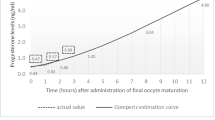Abstract
Objective
To evaluate role of serum estradiol levels in predicting likelihood of pregnancy in women undergoing GnRH-a protocol in IVF-ET cycles.
Design
A 3-year retrospective analysis of estradiol levels on down-regulated day 2, day 6, and day of hCG trigger and subsequent clinical pregnancy rates.
Setting
A university hospital tertiary referral centre.
Population or Sample
Women undergoing IVF treatment.
Methods
Hormonal assessment on the down-regulated day 2, day 6, and day of hCG trigger.
Main Outcome Measure(s)
Comparison of hormonal profile, antral follicular count on day 2, endometrial thickness on day of trigger, and number of oocytes retrieved between pregnant and the non-pregnant group. The prediction of IVF success was based on the quantitative levels of estradiol on a specific day in down-regulated cycle.
Result(s)
The overall pregnancy rate was 32.25 % (50/160). Estradiol level on down-regulated day 2 was 31.9 ± 12.6 and on the day of trigger was 1,996.46 ± 1,252.36 in pregnant women, which was significantly higher as compared to estradiol levels in non-pregnant women (27.6 ± 12.3 and 1,525.1 ± 1,116.42, respectively). It was found to be a significant prognostic marker for successful IVF treatment. Estradiol levels on down-regulated day 6 were found to be non-significant between the two groups.
Conclusion(s)
Estradiol level on down-regulated day 2 of menstrual cycle and on the day of trigger was found to have a significant impact on the success of IVF-ET.



Similar content being viewed by others
References
Evers JL. Female subfertility. Lancet. 2002;360:151–9.
2009 Assisted Reproductive Technology, Success Rates, National Summary and Fertility Clinic Reports. National Centers for Chronic Disease Prevention and Health Promotion, 2011.
Scott RT, Toner JP, Muasher SJ, et al. Follicle-stimulating hormone levels on cycle day 3 are predictive of in vitro fertilization outcome. Fertil Steril. 1989;4:651–4.
Licciardi FL, Liu HC, Rosemwaks Z et al. Day 3 estradiol serum concentrations as prognosticators of ovarian stimulation response and pregnancy outcome in patients undergoing in vitro fertilization. Fertil Steril. 1995;5:991–4.
Yanushpolsky EH, Hurwitz S, Tikh E. Predictive usefulness of cycle day 10 follicle-stimulating hormone level in a clomiphene citrate challenge test for in vitro fertilization in women younger than 40 years of age. Fertil Steril. 2003;1:111–5.
Hofmann GE, Danforth DR, Seifer DB. Inhibin-B: The physiologic basis of the clomiphene citrate challenge test for ovarian reserve screening. Fertil Steril. 1998;3:474–7.
Tomas C, Nuojua-Huttunen S, Martinaken H. Pretreatment transvaginal ultrasound examination predicts ovarian responsiveness to gonadotrophins in in vitro fertilization. Hum Reprod. 1997;2:220–3.
Hendriks DJ, Mol BW, Bancsi LF et al. Antral follicle count in the prediction of poor ovarian response and pregnancy after in vitro fertilization: a meta-analysis and comparison with basal follicle-stimulating hormone level. Fertil Steril. 2005;2:291–301.
Ficicioglu C, Kutlu T, Baglam E, et al. Early follicular antimullerian hormone as an indicator of ovarian reserve. Fertil Steril. 2006;3:592–6.
Hull MG, Fleming CF, Hughes AO, et al. The age related decline in female fecundity: a quantitative controlled study of implanting capacity and survical of individual embryos after in vitro fertilization. Fertil Steril. 1996;4:783–90.
Scott RT, Hofmann GE, Oehninger S, et al. Intercycle variability of day 3 follicle-stimulating hormone levels and its effect on stimulation quality in in vitro fertilization. Fertil Steril. 1990;2:297–302.
Ocal P, Aydin S, Cepni J, et al. Follicular fluid concentrations of vascular endothelial growthfactor, inhibin A, inhibin B in IVF cycles: are they markers for ovarian response and pregnancy outcome. Eur J Obstet Gynecol Reprod Biol. 2004;2:194–9.
Khalaf Y, Taylor A, Braude P. Low serum E2 concentrations after five days of controlled ovarian hyperstimulation for in vitro fertilization are associated with poor outcome. Fertil Steril. 2000;74:63–6.
Devroey P, Bourrgain C, Macklon NS, et al. Reproductive biology and IVF: ovarian stimulation and endometrial receptivity. Trends Endocrinol Metab. 2004;15:84–90.
Anifandis G, Koutselini E, Louridas K, et al. Estradiol and leptin as conditional prognostic IVF markers. Reproduction. 2005;129:531–4.
Papageorgiou T, Guibert J, Goffinet F et al. Percentile curves of serum estradiol levels during controlled ovarian stimulation in 905 cycles stimulated with recombinant FSH show that high estradiol is not detrimental to IVF outcome. Hum Reprod. 2002;17:2846–50.
Speroff L, Glass RH, Kase AG. Regulation of menstrual cycle. Clinical gynecologic endocrinology and infertility. Maryland: Williams & Wilkins; 1994. p. 141–83.
Tesarik J, Mendoza C. Nongenomic. Effects of 17 beta-estradiol on maturing human oocytes: relationship to oocyte developmental potential. J Clin Endocrinol Metab. 1995;80:1438–43.
Weghofer A, Margreiter M, Fauster Y et al. Age-specific FSH levels as a tool for appropriate patient counseling in assisted reproduction. Hum Reprod. 2005;20(9):2448–52.
Coroleu B, Barri PN, Carreras O et al. The influence of the depth of embryo replacement into the uterine cavity on implantation rates after IVF: a controlled, ultrasound-guided study. Hum Reprod. 2002;17(2):341–6.
Tomas C, Tikkinen K, Tuomivaara L et al. The degree of difficulty of embryo transfer is an independent factor for predicting pregnancy. Hum Reprod. 2002;17(10):2632–5.
Edgar DH. Estrogen and human implantation. Hum Reprod. 1995;10:2–4.
Makker A, Singh MM. Endometrial receptivity: clinical assessment in relation to fertility, infertility, and antifertility. Med Res Rev. 2006;26(6):699–746.
Acknowledgments
The authors deeply acknowledge the patients for giving consent for the study. Technical assistance from staff of IVF and Reproductive Biology Centre and Department of Biochemistry and Biotechnology is highly acknowledged.
Conflict of interest
None.
Author information
Authors and Affiliations
Corresponding author
Rights and permissions
About this article
Cite this article
Prasad, S., Kumar, Y., Singhal, M. et al. Estradiol Level on Day 2 and Day of Trigger: A Potential Predictor of the IVF-ET Success. J Obstet Gynecol India 64, 202–207 (2014). https://doi.org/10.1007/s13224-014-0515-6
Received:
Accepted:
Published:
Issue Date:
DOI: https://doi.org/10.1007/s13224-014-0515-6




